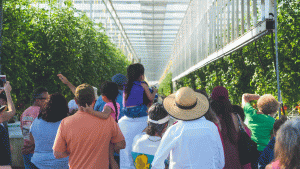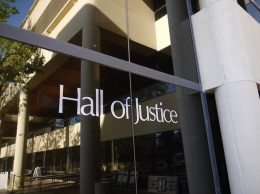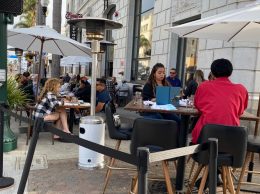
Participants in the 2018 Farm Day tour the climate-controlled greenhouses at Houweling’s Tomatoes.
Santa Maria farmers and agriculture industry specialists plan to open their fields and facilities to the public Sept. 28 when a Ventura County tradition expands into Santa Barbara County for the first time.
Created by Ventura nonprofit Students for Eco-Education and Agriculture, the Farm Day event brought an estimated 5,000 people on a roaming tour of more than 20 agricultural venues in Ventura County in 2018. This year, founder Mary Maranville said the organization hopes to replicate that for more than a dozen row crop growers, vineyards and service providers in the Santa Maria Valley.
“Local growers have seen the benefits and the importance of educating consumers and the community in their own backyard,” Maranville told the Business Times.
Several of the growers that participated in past years have operations in both counties and suggested expanding the program, she said. Known throughout the region as a youth educator, “the trust was there,” when she pitched the idea to a group of around 20 growers last summer.
“One grower raised their hand and just like a domino effect, every grower in the room said yes. It was a very powerful moment.”
SEEAG conducts field trips to a farm in Saticoy for around 4,000 elementary school students every year from districts in Santa Barbara, Ventura and Los Angeles counties. With an annual budget of around $300,000, the nonprofit provides free transportation to the farm and hosts classroom presentations about agriculture and nutrition.
Maranville said questions and interest from parents spurred her to create a similar opportunity for adults.
Ventura County’s Farm Day will be held Nov. 9.
At Farm Day, attendees pick which farms to visit and plan their own itinerary. Since they’re not required to register, farms don’t know until they arrive how many people will attend or when they’ll turn up.
The 13 sites on the inaugural Santa Barbara tour include six growers, a compost facility, a vegetable nursery, a food safety testing lab, two vineyards and wineries, ag educator Allan Hancock College and an experimental pumpkin patch run by North County high school students.
Berry producer Driscoll’s also plans to host a free screening of its documentary “The Last Harvest,” which debuted at film festivals in 2019, at the Santa Maria Edwards Cinema.
The event aims to showcase a mix of agriculture operations and demonstrate new technologies used in growing and harvesting crops, Maranville said.
“We wanted to bring some education not only to the youth but the general public and sort of demystify some of the unknowns that go into farming,” said Brendan Reitsma of Rancho Laguna Farms.
With 200 full-time employees, the farm grows berries, celery, kale, lettuce, cauliflower and broccoli on more than 400 acres in Santa Maria. The Farm Day tour will showcase its recent pilot tabletop strawberry program, launched in partnership with Driscoll’s.
The raised beds bring the berries up to waist height so that workers don’t have to bend down to pick them, reducing the effort required to harvest them and enabling Rancho Laguna to mechanize and automate parts of the process, Reitsma said.
“The biggest thing we want to get to is what it takes to get through the whole process,” said George Adam, owner of Innovative Produce.
Innovative Produce grows a rotation of broccoli, cauliflower, lettuce, celery, romaine and strawberries on 2,000 acres in Santa Maria, and will showcase its newest category, Brussels sprouts, at the Farm Day event.
“Brussels sprouts in particular take a lot of planning,” Adam said. “People need to realize what it takes water-wise, fertilizer, all the cultivation, the bed configurations.”
Growers said they also hope to engage with public perceptions around worker wages and conditions, as well as demonstrate a range of jobs in the industry to a new generation of workers.
SEEAG raised $55,000 for travel, materials and marketing efforts to expand Farm Day into Santa Barbara County, including a $10,000 grant from the Santa Barbara Foundation and several smaller grants from participants and regional ag lenders.
Crop reports released in July show that agriculture was a $4.6 billion industry in the Tri-Counties in 2018, with growers in Santa Barbara and Ventura counties netting $2.1 billion and $1.5 billion in farm gate value, respectively.
In previous years, some locations received as many as 1,000 visitors, Maranville said, but overlap between the sites makes it difficult to get a final tally. Reservations come in from neighboring regions like Bakersfield, Los Angeles and Orange counties.
Even members of the ag community sign up for a chance to see how other crops are grown, new methods of growing like the climate-controlled greenhouses at Houweling’s Tomatoes or the inside of a processing facility like Gill’s Onions, Maranville said.
The nonprofit plans to offer a few suggested itineraries that showcase a variety of ag businesses, she said, such as compost provider Engel & Gray, food safety lab Primus Labs or Plantel Nursery.
The event will keep a narrow focus on operations in the Santa Maria area for the first year in the new county to help participants schedule in multiple stops. In future years, she hopes to open it up to a wider footprint, including growers in the Cuyama Valley.
“You’ve got these very large growers that grow food for a very large portion of the population, and they’re looking at SEEAG, this tiny nonprofit, and saying ‘we’re in,’” Maranville said.
• Contact Marissa Nall at mnall@pacbiztimes.com.






 Print
Print Email
Email
















